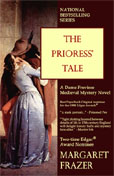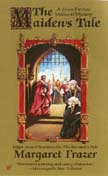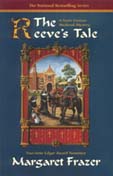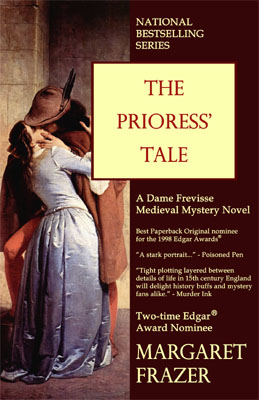With my opening encounter with cancer in 1992, I had a bi-lateral mastectomy. In the six clear years that followed, I wrote six books.
For the first part of this time, I was working with a co-author. Mary and I had a prosperous relationship through the first six books of the series (from The Novice’s Tale through The Murderer’s Tale), but by the end of them she had grown tired of medieval England and our vision for the stories had drifted somewhat apart. She wanted to write warmer murder mysteries – cozies; but I simply do not feel cozy about murder and prefer to explore the deep effects of it on everyone around a wrongful death. Mary so loathed Giles in The Murderer’s Tale, however, that before we were done she could not work on chapters from his point of view. (We will not consider what this says about me, that I was willing to be in Giles’ head.) After that, we parted friends – leaving me in medieval England while she began a new career as Monica Ferris, writing mysteries centered around a modern needlework shop.
I was lucky with The Prioress’ Tale, my first solo effort in the series: Both my agent and my editor told me I waited far too long to kill anyone in it. They said I could get away with it once, but that I should never do that again.
Then it was nominated for an Edgar Award, and after that I was allowed to kill people whenever I wanted to.
From there it was The Maiden’s Tale – story I had been wanting to tell for a very long time – and then on to The Reeve’s Tale. It was while I was working on The Reeve’s Tale in 1998 that the cancer made its first return. The damnable stuff was in my sternum this time, eating a large, tumor-filled chunk out of the bone, and as you can see from the sudden heaping of dedications at the front of Reeve’s, I wasn’t sure I would live to write another book.
This was also when I began my long career of not trusting what oncologists said to me. You see, I had been told that if I made it five years without the cancer coming back, I was cured, in the clear, a success. But at one of the scans to determine what the cancer was doing in the bone, a technician asked me if this was my first time with breast cancer, and when I answered, no, I’d had it six years ago, the technician said casually. “Oh, yes. Six years is when it usually comes back if it’s going to.”
I was left speechless. I had been annoyed at insurance companies because I’d been told none of them would give me health insurance for seven years after the breast cancer had been treated. That had seemed eminently unfair, given the oncologists’ claim – made boldly and often – that if a woman goes clear of cancer for five years, she’s cured. But now I had to consider that the insurance companies had a very good reason for their seven-year limit – and that if the insurance companies knew about the six-year cycle of recurrence, then the cancer community’s claim that “five years and you’re cured” was someone’s cruel, self-serving statistical game to make a good-looking “success rate”.
What makes me a tad bit more bitter is that if I had not accepted the “five years and you’re cured”, I would have figured out far sooner that the excruciating pain in my chest was likely cancer instead of the strained muscle I supposed it was and kept trying to ease, and I would have gone to the oncologist far sooner.
Since then, with fourteen more years experience, I have become wary of the almost-truths and avoidances too many doctors practice to keep control over us (for our own good, of course). Rather than blindly trusting what oncologists or any other physician tells me (no matter how desperately I wish they would just save me), I listen, I judge, I research, I make my choices – often against the advice of my various oncologists over the years – knowing full well that a choice I make could be the wrong choice and kill me. But doctors make those choices for us all the time, all too often “by the book” and without due regard for our personal responses to medications, and their choices also kill. Frankly, if I had been a “good patient” and done as I was told at every turn through these past years, I’d have been dead long since. As it is, I grope onward, hoping for the best.
– Margaret



















